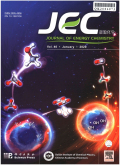- 钛学术文献服务平台 \
- 学术期刊 \
- 工业技术期刊 \
- 石油与天然气工业期刊 \
- 能源化学期刊 \
Three-dimensionally interconnected Co9S8/MWCNTs composite cathode host for lithium–sulfur batteries
Three-dimensionally interconnected Co9S8/MWCNTs composite cathode host for lithium–sulfur batteries
基本信息来源于合作网站,原文需代理用户跳转至来源网站获取
摘要:
Several challenging issues, such as the poor conductivity of sulfur, shuttle effects, large volume change of cathode, and the dendritic lithium in anode, have led to the low utilization of sulfur and hampered the commercialization of lithium–sulfur batteries. In this study, a novel three-dimensionally interconnected network structure comprising Co9S8 and multiwalled carbon nanotubes (MWCNTs) was synthesized by a solvothermal route and used as the sulfur host. The assembled batteries delivered a specific capacity of 1154 mAh g- 1 at 0.1 C, and the retention was 64% after 400 cycles at 0.5 C. The polar and catalytic Co9S8 nanoparticles have a strong adsorbent effect for polysulfide, which can effectively reduce the shuttling effect. Meanwhile, the three-dimensionally interconnected CNT networks improve the overall conductiv-ity and increase the contact with the electrolyte, thus enhancing the transport of electrons and Li ions. Polysulfide adsorption is greatly increased with the synergistic effect of polar Co9S8 and MWCNTs in the three-dimensionally interconnected composites, which contributes to their promising performance for the lithium–sulfur batteries.

推荐文章
大尺度Co9S8纳米线超声喷雾热解制备
Co9S8
纳米线
喷雾热解
超声喷雾热解法制备Co9S8纳米球壳
Co9S8
纳米球壳
喷雾热解
共沉淀法制备Co9S8/C材料以及性能研究
电解水
Co9S8
析氧反应
共沉淀方法
碳材料
水热法合成六角片状Co9S8晶体
Co9S8
水热法
晶体
内容分析
关键词云
关键词热度
相关文献总数
(/次)
(/年)
引文网络
引文网络
二级参考文献 (2)
共引文献 (1)
参考文献 (1)
节点文献
引证文献 (0)
同被引文献 (0)
二级引证文献 (0)
1994(1)
- 参考文献(0)
- 二级参考文献(1)
2008(1)
- 参考文献(0)
- 二级参考文献(1)
2018(1)
- 参考文献(1)
- 二级参考文献(0)
2020(0)
- 参考文献(0)
- 二级参考文献(0)
- 引证文献(0)
- 二级引证文献(0)
引文网络交叉学科
相关学者/机构
期刊影响力
能源化学
主办单位:
中国科学院大连化学物理研究所
中国科学院成都有机化学研究所
出版周期:
双月刊
ISSN:
2095-4956
CN:
10-1287/O6
开本:
出版地:
大连市中山路457号
邮发代号:
创刊时间:
语种:
eng
出版文献量(篇)
2804
总下载数(次)
0
总被引数(次)
7996
期刊文献
相关文献
推荐文献
- 期刊分类
- 期刊(年)
- 期刊(期)
- 期刊推荐
一般工业技术
交通运输
军事科技
冶金工业
动力工程
化学工业
原子能技术
大学学报
建筑科学
无线电电子学与电信技术
机械与仪表工业
水利工程
环境科学与安全科学
电工技术
石油与天然气工业
矿业工程
自动化技术与计算机技术
航空航天
轻工业与手工业
金属学与金属工艺
能源化学2022
能源化学2021
能源化学2020
能源化学2019
能源化学2018
能源化学2017
能源化学2016
能源化学2015
能源化学2014
能源化学2013
能源化学2012
能源化学2011
能源化学2010
能源化学2009
能源化学2008
能源化学2007
能源化学2006
能源化学2005
能源化学2004
能源化学2003
能源化学2002
能源化学2001
能源化学2020年第9期
能源化学2020年第8期
能源化学2020年第7期
能源化学2020年第6期
能源化学2020年第5期
能源化学2020年第4期
能源化学2020年第3期
能源化学2020年第12期
能源化学2020年第11期
能源化学2020年第10期
能源化学2020年第1期

 免费查重
免费查重










